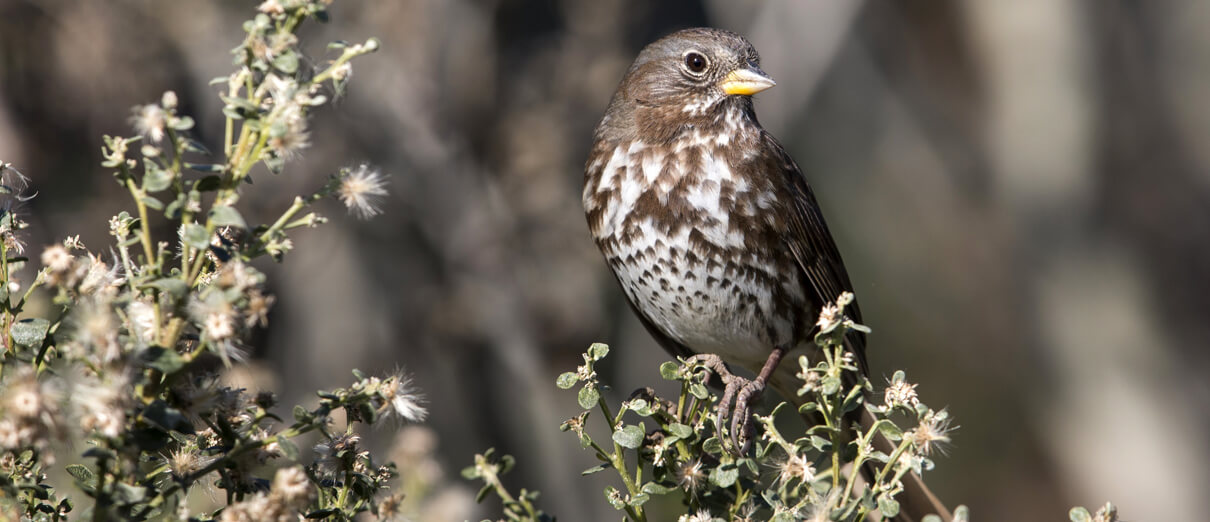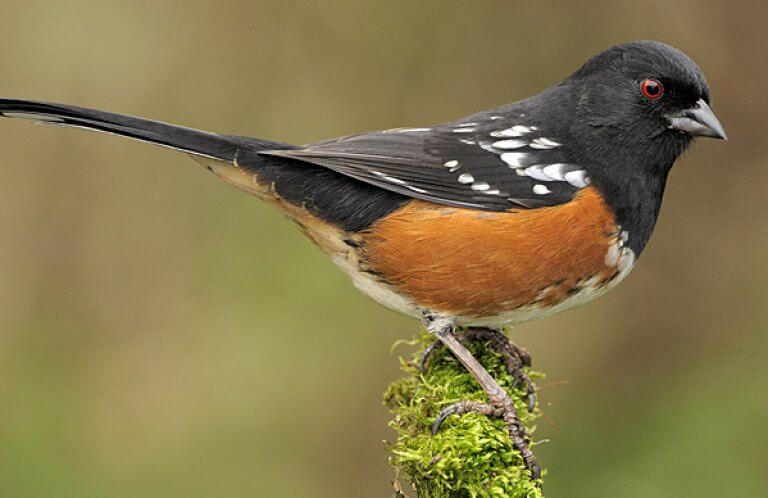About the Fox Sparrow
The stocky Fox Sparrow is one of the largest members of the sparrow family, closer to the size of a Blue Grosbeak than other sparrow species. Despite its size, it's rather shy and retiring, and prefers to stay under cover in dense vegetation, where it may be detected as it rustles through the leaves in search of food, or by its melodious song.
Although named for its “foxy” reddish-orange color, only certain Fox Sparrows sport this descriptive plumage. Individuals in other parts of its wide range have only hints of the warm tones that characterize its eastern relatives.
Like the Hermit Thrush and Song Sparrow, the Fox Sparrow shows significant variation across its geographic range.
Drastic Diversity
The Fox Sparrow is split into a whopping 18 subspecies, comprising four main groups that span North America. From east to west, these groups are the Red, Slate-colored, Thick-billed, and Sooty Fox Sparrows.
The Red form of Fox Sparrow (also known as the Taiga form) breeds across the boreal forests of North America, and winters in the eastern United States. It's the most eye-catching of the groups, with bright rufous and gray plumage, accented by a gray and rufous-striped back and rufous-spotted white breast.
The Slate-colored group, found throughout the interior mountains of the West, is more subdued in appearance, with a solid gray head and back and reddish-brown wings and tail. It has heavy dark-brown breast spotting.
The Thick-billed Fox Sparrow group is found in the southern Cascade and Sierra Mountain ranges, generally south and west of the Slate-colored. Its plumage is similar to that of the Slate-colored group, but it has a hefty bill that makes it look noticeably big-headed.
The Sooty group of Fox Sparrows, found along the Pacific Coast, is a dark chocolate brown, heavily spotted in dark brown below. In bright light, it shows some gray on the face and rust shades in the wings and tail.
Individuals from different groups may interbreed, making a positive ID as to group difficult. Some scientists believe that these four groups may represent separate species, but more evidence for this split is needed.
Songs and Sounds
Many people believe that the sweet, warbling song of the Fox Sparrow is one of the finest among sparrows. See if you agree!
Song:
Song:
Breeding and Feeding
Ground Game
Generally solitary, Fox Sparrows pair up during the breeding season after the male establishes a territory. This sparrow nests on or near the ground beneath dense shrubbery. The female builds her cup-shaped nest out of twigs, dried grasses, stems, and bark. She lines her nest with softer materials such as grass, animal hair, and feathers, and lays 3-5 eggs, which she incubates for about two weeks. Both parents care for the chicks after hatching. The young fledge in about a week and a half; the parents continue to provide food and protection to the young birds after they leave the nest. Like other ground-nesting species such as the Killdeer and Ovenbird, Fox Sparrows use the “broken wing” display to lead predators away from their nests and young. Fox Sparrows can produce two broods per season.

Meals from Scratch
The Fox Sparrow is an omnivore, consuming a varied diet of seeds, wild fruits, insects, spiders, and small snails. Birds belonging to coastal groups may eat tiny crustaceans and other small marine animals.
This sparrow feeds on the ground, usually under dense cover among leaf litter. A noisy diner, it kicks both feet backwards to uncover food in the manner of a Spotted Towhee or White-throated Sparrow, and digs holes in the leaf litter and ground to reach buried seeds or insects.
Fox Sparrows will visit backyard feeders for seed during migration and in the winter.
Region and Range

Although the different groups of Fox Sparrow utilize varying vegetation types depending on their location, all prefer the shelter of thick cover. The species is largely migratory; again, populations vary in distance travelled and route, depending on their location. For instance, Fox Sparrows nesting in the Sierra Nevada of California migrate only short distances, mostly altitudinally, while those from Alaska migrate long distances.
Conservation

Help support ABC's conservation mission!
Fox Sparrows are nocturnal migrants, and so are frequent victims of collisions with glass, towers, and wind turbines. ABC's Glass Collisions program offers solutions to keep migrating birds from hitting windows. Other ABC advocacy programs such as Cats Indoors work to reduce or remove some of the obstacles faced by Fox Sparrows as they migrate.
Get Involved
Policies enacted by the U.S. Congress and federal agencies, such as the U.S. Fish and Wildlife Service, have a huge impact on migratory birds. You can help shape these rules for the better by telling lawmakers to prioritize birds, bird habitat, and bird-friendly measures. To get started, visit ABC's Action Center.
Living a bird-friendly life can have an immediate impact on migratory birds in the United States. Doing so can be as easy as adding native plants to your garden, avoiding pesticides, and keeping cats indoors. To learn more, visit our Bird-Friendly Life page.
American Bird Conservancy and our Migratory Bird Joint Venture partners have improved conservation management on more than 8.5 million acres of U.S. bird habitat — an area larger than the state of Maryland — over the last ten years. That's not all: With the help of international partners, we've established a network of more than 100 areas of priority bird habitat across the Americas, helping to ensure that birds' needs are met during all stages of their lifecycles. These are monumental undertakings, requiring the support of many, and you can help by making a gift today.



















































